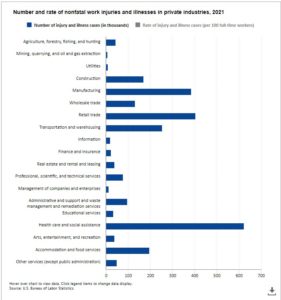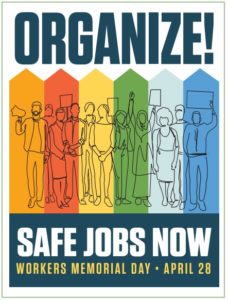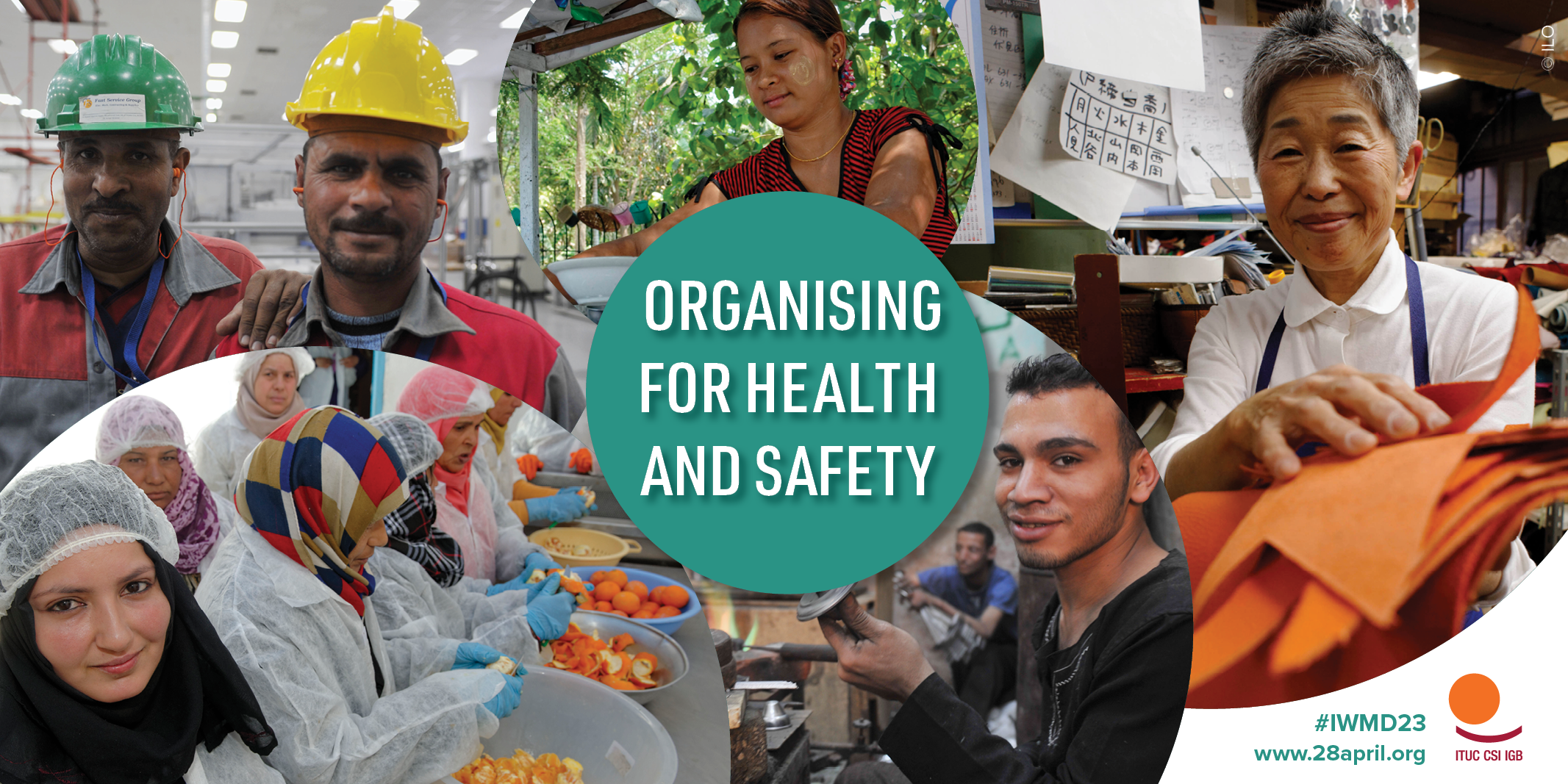Ahh…. as Friday approaches, many working people breathe a sigh of relief. The weekend is in sight, spring is in the air, and there may be some time for a little R&R, even in the crush of chores, kids, and other family matters that need attention. Of course, some will gear up for a full-on working weekend, ensuring that stores and gas stations remain open; mail and packages get delivered; buses, trains, and taxis keep operating; medical services are provided; and our loved ones in nursing homes are cared for.
This coming Friday, April 28, is more than just another Friday. It is Workers Memorial Day, the day when people around the world pause, recognize, remember, and honor those workers who have paid the ultimate price — suffering, dying, or becoming disabled as a result of injuries and illnesses related to their jobs. And then redouble their efforts to make sure that workplaces are safe for the living.
What the Data Does and Doesn’t Tell Us
Fatalities: According to the U.S. Bureau of Labor Statistics Census of Fatal Occupational Injuries, 5,190 workers died as a result of job-related traumatic injuries in 2021, an almost 9 percent increase from 2020. That’s one every 101 minutes. It’s the highest fatality rate (3.6 fatal occupational injuries per 100,00 Full Time Equivalent [FTE] workers) since 2016.
And that’s not the worst statistic: It is estimated that another 120,000 died from occupational diseases (NOT including work-related COVID-19).
Fatality rates for Black or African workers and for Hispanic or Latino workers (4.0 and 4.5 per 100,000 FTE workers respectively) were higher than the all-worker rate of 3.6. More than 20% of workers who died on the job were immigrant workers. Women accounted for 8.6 percent of all workplace fatalities, and workers between the ages of 45 and 54 accounted for just over one-fifth (20.9 percent) of all fatalities in 2021.
The National Council on Safety and Health (COSH) has compiled a detailed database of work-related deaths in 2022. It includes the worker’s name, age, race/ethnicity, date and cause of death, company name and location, and information on inspection status and sanctions. The COSH group will add additional names and information as they become available.
As alarming as these numbers are, they don’t reveal the terror of last moments and the horror that workers’ families and friends must endure when learning the details of their loved one’s death — perhaps buried alive in a trench collapse; mangled by a machine; crushed by a falling object; asphyxiated by a deadly gas; run over by a vehicle; murdered by a depressed or angry client, customer, patient, or co-worker; or killed in the line of duty as a police officer, firefighter, or emergency responder. Confined Space — a newsletter singularly focused on worker health, safety, and labor issues – provides a Weekly Toll that recounts these tragedies.
Non-fatal injuries and illnesses: According to the Bureau of Labor Statistics (BLS), private industry employers reported 2.6 million non-fatal workplace injuries and illnesses in 2021 – down 1.8% from 2020 (likely due to the pandemic-related economic downturn) – and 642.8 thousand in state and local public sector workplaces. More than one million private industry cases (1,062,700) resulted in days away from work.
RED FLAG: These data only tell part of the story, as occupational injuries and illnesses are both under-recognized and under-reported (see here, here, here, here).
Good News and Bad News
Let’s start with the best news: workplace injuries, illnesses, and deaths are preventable. They don’t need to happen. Resources abound for employers and for workers.
Government standards and guidance, employer best practices, unions and worker health and safety committees are all part of the prevention toolbox, not to mention just plain common sense. And the law requires that employers furnish workplaces free from recognized hazards (OSH Act, General Duty Clause, Section 5(a)(1).)
Since the passage of the Occupational Safety and Health Act in 1970 and the Mine Safety and Health Act in 1969, critical health and safety standards have been enacted that employers must comply with. Working conditions have improved, and thousands of lives have been saved.
Today, more and more workers and unions are organizing and fighting for a living wage and for better benefits and working conditions. Workers are taking action to press their case.
Non-Governmental Organizations, think tanks, academic centers, and worker advocacy groups are speaking out on worker safety and health and other labor issues with reports, op-eds, articles, blogs, listservs, and engagement in the policy process around issues like child labor, heat, meat and poultry hazards, Amazon, and others (see also here, here, here, here)
President Biden’s Fiscal Year 2024 budget proposal invests $2.3 billion, an increase of $430 million over the FY 2023 enacted level, in the Department of Labor’s worker protection agencies.
The Occupational Safety and Health Administration’s budget is pitifully small and has remained flat over the past decade, but the FY 2024 Biden budget proposes a 17% increase for OSHA and a 13% increase for the Mine Safety and Health Administration. (Spoiler: it inexplicably proposes a 2% decrease for the National Institute for Occupational Safety and Health, the nation’s only federal worker health and safety research agency).
Now for some of the bad news (see Page 23-24, AFL-CIO Worker Memorial Day Toolkit)
- OSHA remains underfunded and understaffed. The agency’s FY2022 budget ($632 million) amounts to about $3.99 per worker, and there is only one OSHA inspector for every 77,334 workers.
- Penalties for fatalities and serious violations remain too low, essentially a slap on the wrist.
- Millions of state and local public sector employees lack OSHA protection.
- Many workers still fear and face retaliation by their employers for raising safety concerns or reporting injuries.
- Child labor laws are under attack and agencies that enforce child labor protections are severely underfunded.
- Employers have increased their use of temporary workers and independent contractors and misclassify employees as contractors. This ploy shifts responsibility for safety onto workers and makes it more difficult for agencies to hold the employers accountable.
Advocacy and Action Needed

We’ve come a long way over the last 50 years, but much more needs to be done. It’s well past time for a permanent OSHA COVID-19 standard for health care workers, as well as protections for those who work in congregate settings, such as food processing, corrections, and transportation. OSHA needs to enact safety and health protections against workplace violence, infectious diseases and heat, and the agency needs to modernize its Process Safety Management standard to protect workers in chemical facilities. At MSHA, it’s past time to issue the silica standard it’s been working on for years to prevent the increase in black lung cases.
Congress can and should do more to protect our nation’s workers by passing the Protecting America’s Workers Act (PAWA), introduced every Congress in both the House and the Senate. The Act would expand OSHA coverage to public sector workers in the 23 states without it, strengthen whistleblower protections and increase penalties.
Congress should provide OSHA, MSHA, and NIOSH with the resources these agencies need to fulfill their statutory responsibilities and protect our nation’s workforce, which is ultimately the powerhouse of our economy and the bedrock of our families and communities.
Renewing Our Commitment
Workers Memorial Day reminds us not just to mourn for the dead, but also to Fight for the Living. So, Friday is a day to reflect on what we can bring to the effort in the months ahead to ensure that our working brothers and sisters can come home to us safe and healthy at the end of every workday.
It takes commitment and collective action. Together we are a powerful force.
Together, we can say enough is enough.
Let’s do this.
Workers Memorial Day Resources:
The AFL-CIO Workers Memorial Day Toolkit
National COSH Workers Memorial Day Week
Hazards Magazine List of Events Worldwide
Kathleen Rest is the former Executive Director of the Union of Concerned Scientists and Former Acting Director, National Institute for Occupational Safety and Health (NIOSH).

[…] The following excerpt is from Confined Space, the excellent US work safety and labor issues blog. To read the complete story click here: […]
[…] This post was first published on Confined Space. […]
[…] along with a call to action for improving worker safety and health (full article available: jordanbarab.com/confinedspace/2023/04/25/workers-memorial-day-2023/). The article highlighted the ongoing challenges in occupational safety and health, emphasizing the […]
[…] Memorial Day, as you’re all aware, is a day to mourn for those killed in the workplace and fight for the living. Events were held all over the country this year. Below is a list of […]